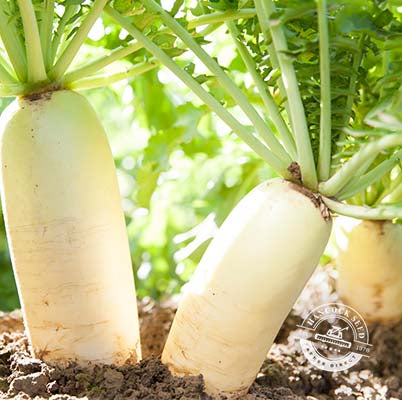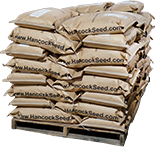Daikon Radish is great for food plots, winter cattle forage and soil improvements.
Product Information
- Application or Use: Pasture, Cattle Forage, Livestock Grazing, Food Plot, Soil Improvement
- Germination Time: 5 - 7 days, under optimal conditions
- Growing Locations: Warm Season, Transition Zone, Cool Season
- Height: 1 - 2 feet
- Sunlight Requirements: 6 - 8 hours, full sun for best results
- Advantages: Handles grazing pressure well - sprouts new growth quickly.
- When to Plant: Recommended planting time is spring and fall when night time temperatures are consistently below 65 degrees.
Product Details
- GMO-Free
- Fast growing, will smother weeds
- Handles grazing pressure well - sprouts new growth quickly
- Protein levels in the top and root are better than 20%
- Radishes aerate and loosen compacted soil, even heavy clay
Product Information
Daikon Radish is great for food plots, winter cattle forage and soil improvements. Daikon Radish tap root looks like carrots growing to lengths of 18 to 24 inches. Deer eat both the green top and the radish itself. Daikon Radish is also used in soil improvements as well as cover crop. Daikon Radish is very aggressive and will germinate and thrive in most soils types around the world. Great for no till food plots!
One of the biggest benefits behind Daikon Radish is its potential as a source of forage for both deer and cattle. Because the Daikon Radish is so hardy, it can thrive in almost climate and will continue to thrive even as Winter temperatures set in. This makes Daikon Radish a popular form of cattle forage during the Winter months as well. During the Summer, it's just as popular a source of forage because of its aggressive growing tendencies, and how quickly it sprouts new leaves after being consumed.
Daikon Radish have been a popular as a form of sustenance for residents of Southeast Asia for thousands of years. Thanks to its mild taste, it has found new audiences across the world in more recent years. Daikon Radishes can be stored for weeks, even without their leaves, if they are stored in a cool place. In Japanese cuisine, they are often pickled.
Obviously the large root leaves behind a significant cavity in the soil, making it an optimal option for breaking up soil, including heavy clays, for those who wish to plant new crop options in years to come. Studies have shown that this taproot leaves more than 6 to 10 inches of effect on soil compaction. The word "Daikon" actually translates to "big root" in Japanese!
One additional way to use your Daikon Radish is for the traditional Japanese art of Rokusho, patination or coloring of non-ferrous metals. One of the last steps in the process is to actually rub down the treated metal, which has traditionally been done for centuries by using a Daikon radish! Hancock Seed cannot, however, provide all the copper acetate, sodium hydroxide and other chemicals required for the process. Actually, we're just going to recommend you use this amazing root as a cover crop, wildlife forage option, or for your own table!
*Product packaging may appear different than what is pictured.
**Daikon Radish Seed is GMO-Free**

Daikon Radish will thrive in any one of the three climate zones, when planted during the late Summer, or early Fall. Seed at a rate of 10 to 15 lbs. per acre, and fertilize at a rate of 300 lbs. per acre with a 19-19-19 fertilizer (equal parts nitrogen, phosphorus and potassium). Cover seed at a depth of half-an-inch.
We recommend rotating Daikon Radish fields at least every 2 to 3 years to prevent the development of fungi.
Daikon Radish Seed
Daikon Radish is great for food plots, winter cattle forage and soil improvements.
...
Instructions
For more info on planting instructions and tips for the best results – check out our Warranty & Planting Information here!
Daikon Radish will thrive in any one of the three climate zones, when planted during the late Summer, or early Fall. Seed at a rate of 10 to 15 lbs. per acre, and fertilize at a rate of 300 lbs. per...









































